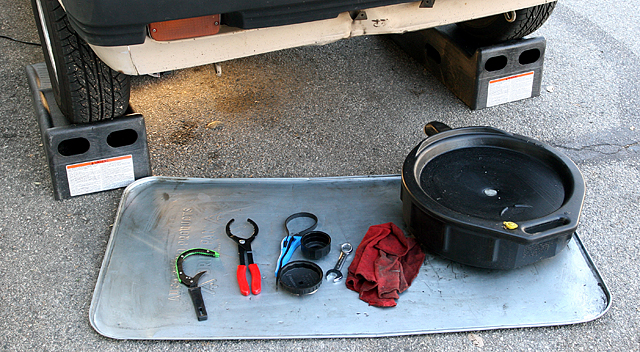 Changing the oil and filter on a regular basis is the single best way to keep an engine running as long and best as possible. A thin film of oil molecules is the only thing that keeps gnashing engine internals from turning into an expensive heap of scrap metal by way of friction and heat. Another function of engine oil is to keep those same engine parts clean. Dropping out the oil and swapping in a new oil filter takes but about an hour, and can mark the beginning of a do-it-yourself tradition of maintaining your engine and wrenching on your ride.
Changing the oil and filter on a regular basis is the single best way to keep an engine running as long and best as possible. A thin film of oil molecules is the only thing that keeps gnashing engine internals from turning into an expensive heap of scrap metal by way of friction and heat. Another function of engine oil is to keep those same engine parts clean. Dropping out the oil and swapping in a new oil filter takes but about an hour, and can mark the beginning of a do-it-yourself tradition of maintaining your engine and wrenching on your ride.
Why Change the Oil?
Even though engines run cleaner and more efficiently than ever before, some of the by-products of combustion end up as junk in the oil. A certain amount of metal will also float into the oil as the engine normally wears. Engine oil and oil filters can only suspend and contain so much crud and combustion by-products, before the balance of lubrication shifts away from trouble free motoring and towards engine wear. Changing the oil and filter gets rid of the crud. The engine stays cleaner and lasts longer.
E-Z Step-by-Step How-to Change Oil and Filter
When to Change the Oil
The best advice to follow as far as engine oil and filter changes comes from the folks that built your car. Every 3000-5000 miles or three months is conventional thinking. Stop-and-go city driving can qualify as “severe duty” when it comes to maintenance schedules, and require more frequent changes. Spending 20 bucks on an oil and filter change every few months is still less costly than a new engine – even over the course of multiple oil changes. Always prevent oil spills by containment. Drain containers and drip pans are also cheap, making it easy to recycle the used oil and properly dispose of the filter.
Useful Things:
- Drive-on ramps or a jack and jack stands
- The biggest drip pan that fits under the engine
- A container or oil drain pan to catch and store used oil
- A wrench for the drain plug
- Oil filter wrench
- Recommended oil and oil filter
- Disposable gloves
- Shop rags, and lots of them
- A new drain plug gasket










Worth noting that many newer cars have underbody skiplates/plastic tray thingies that must be removed. This can be a bit of a pain.
What’s the Clunkbucket recommended disposal method for the actual oil containers?
I put mine in the home recycling bin, under the assumption that whatever process is applied to plastic items would do just as well to re-purpose the remaining oil residue.
I usually buy the oil in the five-quart containers, put ’em in with the recycle, or bring ’em back with the used oil.
Great website for finding places where you can get rid of your automotive fluids, http://earth911.com/
Most Auto Stores have containers in the back room for used oil. Just ask and they will usually take it free of charge. At least mine does when I changed oil last month for my Fit they told me walk to the back room and look for the big blue container that has oil all over it.
I’d like to compare two sentences that occur back to back in the post:
“The best advice to follow as far as engine oil and filter changes comes from the folks that built your car. Every 3000-5000 miles or three months is conventional thinking.”
The first is more important than the second. That “conventional thinking” seems to come more from oil change shops and mechanics who have a vested interest in more frequent oil changes – namely they have boat payments due. My 1988 Grand Caravan, 1999 Honda Odyssey and 2005 Mazda3 S all recommended a 7,500 mile interval under normal driving.
I’ve heard that some, like BMW which has an on board computer that tells you when to change the oil, recommend changes at 10,000 or even 15,000 miles. Bottom line is the manufacturer knows better than the local oil change shop or even the dealer how often you should change your oil.
You need to get the engine up to operating temp before you drain the oil for one reason. Detergent engine oil holds “dirt” in suspension when it gets hot. When your engine is cold and not up to temperature, a considerable amount of filth in the oil stays on all of the internal components in the engine. When hot it cleans and removes the carbon and extra junk (to an extent) and holds it in suspension of the oil. The engine oil is dirtier when its hot, leaving you with a cleaner engine. If you drain it cold, of course it will still be filthy and look like hell but a significant amount of contaminants are still hanging out in your engine, just waiting to molest the new oil that you put in, there for shorting the service life immediately. Yeah, the BMW computer system isn’t going to know that either, same thing with GM oil service indicators. No indicator is better than a competent technician evaluation of the engine oil condition on the dip stick. If you cant find one competent enough to accurately diagnose that, please contact me, I’d be more than happy to share my knowledge.